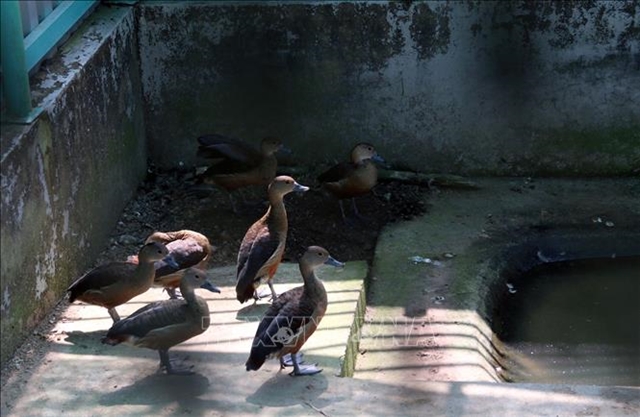 Environment
Environment


|
| The birds are rescued and kept in the Wildlife Rescue Centre at the U Minh Thượng National Park in the southern province of Kiên Giang. — VNA/VNS Photo |
KIÊN GIANG — The Wildlife Rescue Centre, at U Minh Thượng National Park, in the southern province of Kiên Giang, has rescued hundreds of animals over the years and saved the lives of many rare wildlife species.
Being surrounded by forest with an area of nearly four hectares, the centre has become the second home of the animals.
Established in June 2013, the centre is responsible for accepting animals confiscated from law violators or voluntarily submitted by organisations for treatment and rehabilitation.
Depending on their health, the animals are re-released to their natural habitat after a period of care at the centre.
Creatures that have lost their wild instinct and are unable to survive on their own in the natural environment stay at the centre.
The centre's staff have contributed to storing and conserving endangered, precious and rare species.
The centre's animal rescue team has eight staff that take meticulous care of the animals day and night.
“Seven o'clock is the start of work every day. Our jobs are to regularly monitor and check the animal's health, clean cages. Usually, we finish work at 5pm, but sometimes stay up all night to look after sick animals,” Néang Mala, an animal rescue team staff, said as she was taking care of a two-year-old hairy-nosed otter.
Néang Mala, a Khmer ethnic woman, added: "A tourist travelling in U Minh Thượng National Park presented the newborn otter to the centre in 2019."
“After receiving it, the other staff and I took turns feeding him milk and daily health monitoring. For nearly two years, it has been taken care of and grown up well.”
In the centre, the cages are built close together, suitable for the living environment of each species and each cage has a board of contents that clearly states the names and characteristics of each species.
The artificial breeding environment has helped some rare and precious animals to escape the danger of extinction, according to Sử Hữu Song, Director of the Centre.
Currently, the centre is taking care of 34 wildlife species with 213 individuals, including 17 species of endangered, precious and rare animals such as hairy-nosed otters, small-clawed otters, yellow-cheeked gibbons, Bengan cats, horse-headed bats, Indian storks, Lesser Adjutant stork, varans and civets.
Not only ensuring the safety of animals, the centre’s staff always strive to create a living environment to help them keep their natural habits, said Song.
“Each animal brought to the centre will be taken care of carefully and attentively so they can quickly restore their function and have enough ability to live when they are re-released to the natural environment,” he said.
The director said the centre regularly called on the community not to hunt and capture wild animals in the forest and many people and organisations have contacted the centre to hand over some rare animals.
Song, who has been with wildlife rescue for many years, said: "It can be summarised in a sentence: animal rescue is like firefighting.
"Sometimes if we're just a little slow, nature loses a rare animal species.
“The staff must learn the specific habits and habitats of each species, to have appropriate care methods so they feel like they are living in a natural environment.”
Since 2015, the centre has rescued 745 wild animals and has released 694 into the environment.
The centre has also raised five other wildlife species and three of them successfully reproduced here.
U Minh Thượng, literally translated as Upper U Minh, in the southwestern province of Kiên Giang, is part of U Minh – the most extensive peat swamp area and the richest place of plant and animal biodiversity in the Mekong River basin. VNS




